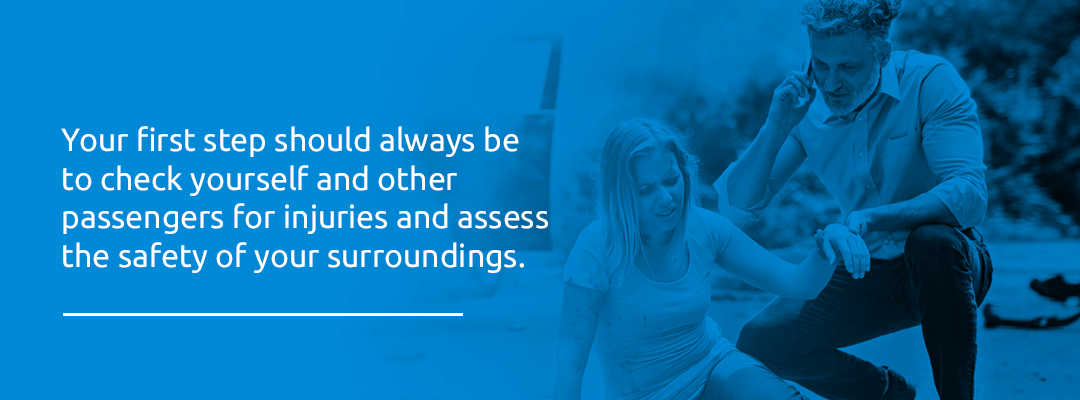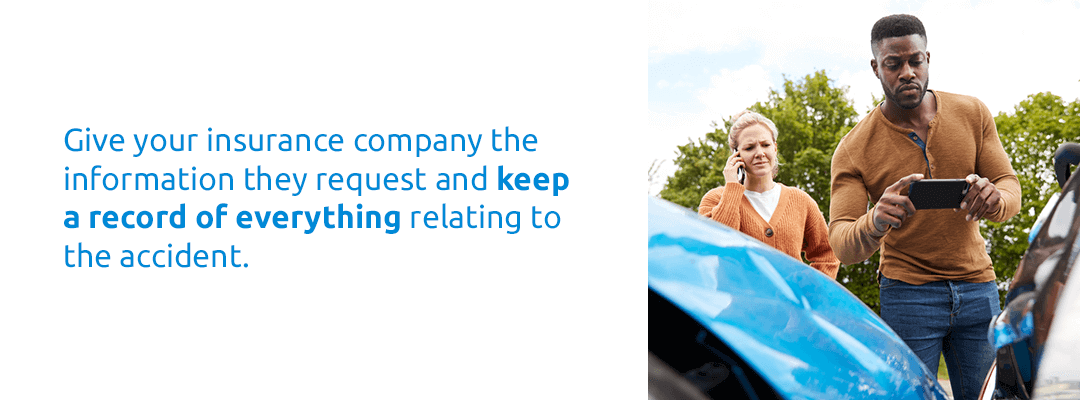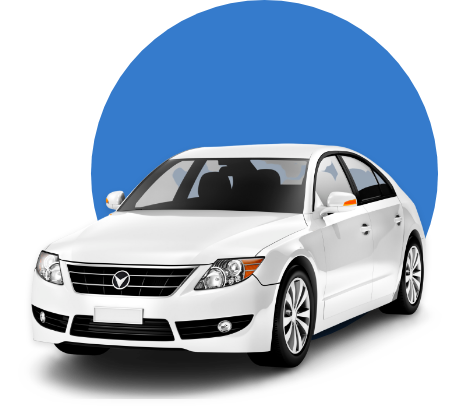Chapter 1: Car Accidents and Insurance Claims
Imagine you’re driving home from work, thinking about what you’ll have for dinner, and the next thing you know, you’re in a ditch. Car accidents happen to just about anyone, including those who have been driving for decades. The National Highway Traffic Safety Administration reports that around 6 million motor vehicle crashes occur annually. Most drivers experience at least one accident throughout their lifetimes.
Although you can’t predict what will happen every time you get behind the wheel, you can prepare for surprises with a well-chosen car insurance policy. In this chapter, we’ll explore the different types of car insurance to help you feel safer when walking out the door. We’ll also take you through the auto insurance claims process, so you know what to expect if an accident happens.
What Are the Benefits of Car Insurance?
Having car insurance offers more than keeping you in line with the law. Depending on the type of coverage you have, it can make a significant impact on accident-related expenses and may save you from lawsuits or an empty bank account. You can expect benefits such as:
- Protects you financially: If you’ve ever been in a car accident, you know they come with a high price. Accidents can lead to thousands of dollars in repairs, medical bills or lost wages, for you or the other party. Chances are that you’d rather not pay to replace someone else’s car out of pocket. Car insurance protects you from immense accident-related expenses and allows you to get on with your life.
- May cover non-collision accidents: Other vehicles aren’t always the cause of an accident. Think of a time when an animal bolted in front of you as you drove along, unsuspecting. Large animals, such as deer, can do a lot of damage to your car. As a Missourian, you may want to prepare for this. According to the Missouri Department of Insurance, the state experiences over 3,500 deer strikes a year. One way to protect yourself financially against accidents with animals, falling objects, theft and weather events is to purchase comprehensive insurance.
- Saves time and stress: Accidents can be extremely stressful, time-consuming events, especially if you don’t have the right insurance policy. You likely won’t be eager to go to court as you recover from an accident — or at any time. Fortunately, car insurance makes the process less nerve-racking and leaves most of the work to insurance adjusters. With good insurance, you can focus on healing or getting your car fixed.
- May reduce medical expenses: Depending on your policy, car insurance might help you pay for accident-related medical expenses not covered by your health insurance plan. This may include dental work, chiropractic care or other services needed to treat you after an accident.
- Provides peace of mind: On average, Americans spend nearly an hour in their car every day. When you have adequate car insurance, you can enjoy your daily commute with peace of mind because you won’t have to worry about using your own money in case there’s an accident. If you have rental reimbursement coverage added to your policy, you can also be sure you’ll have reliable transportation after an accident.
- Might help you if you break down: You might be able to add roadside assistance to your insurance policy, which typically provides basic services such as towing, repairing a flat tire or jumping a dead battery. This is another way to feel more assured as you drive, and it can be a lifesaver.
Request an Auto Insurance Quote!
What Are the Types of Car Insurance?
Several types of car insurance are available, and each one offers unique benefits. You’ll also encounter a range of optional coverages to enhance your policy, which we’ll cover in the next chapter.
In most states, you need to have minimum coverage, which is usually liability insurance. In Missouri, all drivers and vehicle owners are required to have liability insurance plus uninsured motorist coverage. Here’s a general overview of common car insurance types:
- Liability: Liability insurance covers the other party’s medical bills and car repairs if you cause an accident, but it does not cover the cost of your medical expenses or vehicle repairs.
- Collision: Collision insurance covers the cost of your vehicle repairs or replacement resulting from an accident. The law does not require this type of coverage.
- Comprehensive: Comprehensive insurance protects you financially if your car is damaged by theft, weather events, animal strikes or falling objects. Like collision, comprehensive insurance is optional. However, if you have a loan on your vehicle, the lender may require both collision and comprehensive coverage.
- Personal injury protection (PIP): PIP covers medical expenses regardless of who’s at fault and may cover costs not typically covered by health insurance, such as lost income, child care or funeral expenses. PIP covers you and your passengers up to a limit. Although you don’t need PIP in Missouri, you must carry PIP in no-fault states, such as Kansas.
- Medical payments (med-pay) coverage: Med-pay is similar to PIP and usually available in at-fault states. It covers accident-related medical expenses of you and passengers up to a limit. Med-pay and PIP are alike in many ways, though, generally, med-pay will not cover wage reimbursement or childcare expenses.
- Uninsured or underinsured motorist coverage: Uninsured or underinsured motorist insurance covers medical bills and car repairs if you get in an accident with a driver who does not have any car insurance or who has inadequate coverage. Many states require drivers to carry uninsured or underinsured motorist coverage, which is probably a good thing. About one in eight drivers do not have any car insurance.
- Non-owner car insurance: Non-owner car insurance provides liability coverage for individuals who drive but do not own their car. Non-owner car insurance typically includes the minimum state requirements. You might choose this type of policy if you frequently rent cars or often borrow vehicles from others.
What Is the Auto Insurance Claims Process?
Immediately after a car accident, you probably won’t be skimming through your insurance documents. Your first step should always be to check yourself and other passengers for injuries and assess the safety of your surroundings. Once you’ve determined you’re out of harm’s way, call the police. Insurance companies will use the police report to figure out what happened.
Next, exchange information with the other party. You’ll want details such as their name, address, phone number, license plate number and insurance information. Take photos of the scene, including pictures of skid marks or any property damage that may have occurred.

After you’ve received medical attention, if necessary, it’s time to file a claim. The claims process typically follows these steps:
1. Call the Insurance Company to File a Claim
The claim is your request to an insurance company to compensate you for accident-related expenses. You want to file your claim as soon as possible. You can either make a first-party claim or a third-party claim. A first-party claim is one you file with your insurance company. You might file a first-party claim if you hit an object, like a tree, and have collision coverage. You might also make a first-party claim if you have uninsured or underinsured motorist coverage.
Remember that any time you file a claim with your insurance company, it may increase your premium. Claims are also reported to the Comprehensive Loss Underwriting Exchange (CLUE), which can impact your premium when you shop for insurance in the future.
A third-party claim is the one you file with the other party’s insurance company if they are at fault. As long as the other party has sufficient car insurance, their liability coverage will pay for the damages caused to your vehicle and any related medical expenses.
2. Wait for the Adjuster to Examine the Claim
After you file a claim, an insurance adjuster will contact you for more information about the accident. They’ll want to investigate your claim, so the more proof you have to support your request, the better. For example, you can use the police report to support your claim, but you may have to wait a week or two to get a copy of the report.
You can also have the vehicle inspected by a car repair shop to get an idea of how much it will cost to fix the damage. The insurance adjuster may accept your estimate or decide to inspect the vehicle and get their own estimate. If the adjuster chooses to inspect your car, they will schedule an appointment with you to evaluate the damage that occurred.
3. Negotiate Compensation
After you and the insurance adjuster have estimates, you can negotiate about the compensation you’ll receive. Usually, insurance adjusters offer an amount that is too low, which you don’t have to accept. Calculate the costs of the accident-related expenses, including any long-term medical care you may need and pain and suffering you’re experiencing, and determine the amount you’re willing to accept.
After negotiating, the adjuster will approve a final payment that you may accept to resolve the claim. If the adjuster refuses to offer a reasonable settlement, you can file a complaint with the court.
What If the Accident Was Your Fault?
If you were responsible for the accident, avoid admitting fault, and instead, let the insurance adjusters figure out fault based on the evidence. If you’re in a multi-vehicle accident or are not sure who’s at fault, call your insurance company for help. In such a case, you may need to file a first-party and a third-party claim.
What If the Accident Happened in a Parking Lot?
If the accident occurred in a parking lot, expect adjusters to find the accident half your fault and half the other party’s fault. You can still file a third-party claim after a parking lot accident and avoid admitting fault.
Get a Custom Quote!
How Do I File an Auto Insurance Claim?
Before you call the other party’s insurance company to file a third-party claim, it helps to have the following information ready:
- The other driver’s name and insurance policy number
- Evidence to support your claim, such as the police report and photos
Remember to file the claim as soon as you can, because the longer you wait, the greater the chance it will get denied.

If you decide to make a collision claim or an uninsured motorist claim, contact your own insurance carrier. To file a claim with your carrier, have your insurance policy information ready when you call. When you speak to an insurance adjuster, ask questions about the process, such as how long it’ll take and the deadlines you need to know. Also, find out if your insurance plan covers the cost of a rental car if needed.
Give your insurance company the information they request and keep a record of everything relating to the accident. Keep in touch with your insurance company and contact them whenever you have a question or need more information.
What Are the Most Common Types of Car Accidents?
Can you recall your first car accident? Most accidents occur at intersections, but they also commonly happen in stopped traffic or if a driver runs off the road’s edge. The most common types of car accidents include:
- Rear-end collisions: A rear-end collision might happen if someone follows you closely and can’t react fast enough if you suddenly stop. One way to prevent this type of crash is to give plenty of room between you and the car in front of you. If someone is tailgating you, avoid speeding up. If you drive slower, you can reduce the impact if an accident occurs. Consider moving aside to let them pass as soon as you find a safe spot to pull over.
- Side-impact collisions: Side-impact or T-bone collisions typically happen at intersections and can lead to a serious accident. To help prevent a side-impact collision, always be aware of your surroundings when you drive, and avoid speeding to beat a red light.
- Front-impact collisions: Front-impact collisions account for over half of serious car accidents. They include head-on crashes with another car or object. This type of collision might happen if the driver is distracted or slips on ice. To avoid a front-impact collision, always pay full attention when you drive and take extra precautions when the roads are slick.
- Low-speed parking lot collisions: Drivers might hit other cars in a parking lot because they can’t see around other vehicles or they aren’t paying attention. To help prevent a parking lot accident, check out your surroundings before you get into your car. If you can’t see as you back up, help others see you by turning your lights on or tapping your horn a couple of times.
- Hydroplaning: Hydroplaning occurs when your tires float on water and can happen when you drive too fast on a wet road. Hydroplaning can cause drivers to lose control of their vehicles and run into objects or other cars. If you start to hydroplane, take your foot off the gas but avoid slamming on your brakes or jerking the wheel. Brake slowly or let your car coast until the tires contact the pavement again.
- Animal collisions: Animal collisions can cause severe damage, especially if you run into a large animal. You’re more likely to have an animal-related accident on a rural or suburban road, and at certain times of the year. For example, deer are most active from October through December. During this time of year, drivers are at greater risk of colliding with a deer.
What If the Other Driver Is Uninsured or Underinsured?
Suppose you get in an accident with an uninsured or underinsured driver. In that case, you’ll need to call your insurance company to file a claim and use your uninsured or underinsured motorist coverage. In Missouri, drivers are required to carry uninsured motorist coverage. Overall, you’ll want to take these steps after an accident with someone who doesn’t have car insurance:
- Call the police.
- Take photos of the accident and get as much information as possible about the other vehicle and driver.
- If the other party has insurance, call their carrier even if they are underinsured.
- File a claim with your insurance company if you have uninsured or underinsured motorist coverage.
If you do not have uninsured or underinsured motorist insurance, call your insurer and find out if collision or med-pay will cover the costs of the accident. Lastly, if you do not have any insurance other than liability coverage, consider calling an attorney. Otherwise, you’ll need to pay for accident-related expenses yourself.
You can prepare for an accident with an uninsured driver by getting coverage first. Contact us at David Pope Insurance to learn more about uninsured motorist coverage.


